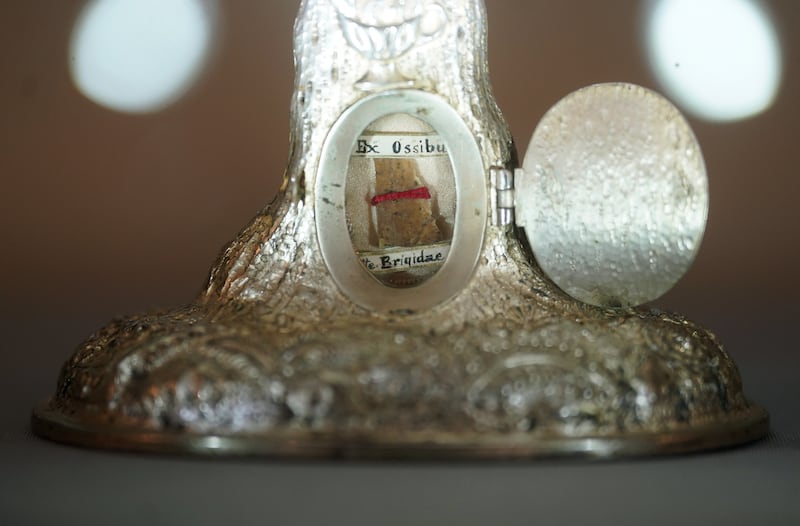St Brigid, the patroness of Ireland, has come home to Kildare town 1,500 years after her death.
The relic of a bone fragment from her skull is contained inside a specially commissioned silver representation of an oak tree in a red box. It was brought to St Brigid’s parish church for a special Mass which begins a year of celebrating the life of the saint, who died, tradition tells us, around the year 524.
[ Modern day Brigids tell their storyOpens in new window ]
The relic is almost as storied as the saint herself. In the early centuries of the Catholic Church, saints were made by popular acclamation, and relics were much sought after. St Brigid’s grave in Co Kildare was adorned with gold and precious jewels. Her remained were moved in 800 to Downpatrick to escape marauding Vikings, and she was buried beside St Patrick and St Columba.
In 1283, three Irish knights arrived in Portugal en route to the Holy Land to fight in the Crusades. Before leaving they decided to dig up her remains and bring with them the relic of Brigid’s skull. For reasons unknown they were killed at Lumiar, outside Lisbon, and the relic remains there to this day at the church of St John the Baptist – the last resting place of the three knights in question.
No grand designs: Why are so many new buildings in Dublin ugly?
Michael Flatley: The deal that let the dancer keep his Castlehyde mansion
Leaving Cert 2025 students will lose out due to grade deflation, but by how much?
Distressing news about Elton John and Madonna. We don’t get too many cask-strength feuds any more

Portions of the skull were gifted to St Brigid’s Church in Kilcurry, Faughart, Co Louth, in 1905 and to St Brigid’s Church in Killester, Co Dublin, in 1929. The third portion of the skull was gifted in the 1930s to the Order of Brigidine Sisters in Tullow, Co Carlow, for private veneration. It is that portion that has been gifted to Kildare. It is the first time that the county has had a relic of St Brigid for more than 1,000 years.
The relic will now go on permanent display in the church, where it is hoped it will prove not just an object of veneration, but a potential tourism attraction. Kildare Fáilte chief executive Áine Mangan said she hoped the relic will lead to “a new camino in Co Kildare”.
[ Romantics head for St Valentine’s shrine for a blessing – and a kissOpens in new window ]
The Irish Provincial of the Brigidine Order, Sr Theresa Kilmurray, carried the relic from the Solas Bhríde outside the town to the church, preceded by a Garda escort, with three young women on horseback representing the three knights who brought the original relic to Portugal.
It was received at the church door by the Bishop of Kildare & Leighlin, Denis Nulty, who led the procession to the altar, which was decorated with representations of newborn lambs and spring flowers, a reminder that February 1st, the first day of the chronological spring, is based on the Celtic festival of Imbolc.
“This is a wonderful day for Kildare,” Bishop Nulty said. The lives of the early saints were shrouded in mystery and it is hard to know where fact ends and myth begins, he added, quoting from Sr Rita Minihan, an authority on St Brigid: “The more one tries to unravel the mystery, the more the mystery deepens.”
He described St Brigid as “hospitable, a peacemaker, a strong woman of faith”. For Brigid, the visitor was always a representation of Christ. It was ironic that protests against the housing of asylum seekers had been taking place recently outside centres named after the saint – a reference to protests outside the now-disused St Brigid’s maternity hospital in Carlow town.
[ Sacred hearts, stereos, JFK and ashtrays: 22 relics of Irish homes pastOpens in new window ]
“This is not the hospitality that Brigid espoused. It is anathema to everything Brigid stood for,” the bishop told a full congregation at the church.
After its installation in the nave of the church, hundreds of people queued to touch the relic and photograph it with their smartphones.
- Sign up for push alerts and have the best news, analysis and comment delivered directly to your phone
- Find The Irish Times on WhatsApp and stay up to date
- Our In The News podcast is now published daily – Find the latest episode here











